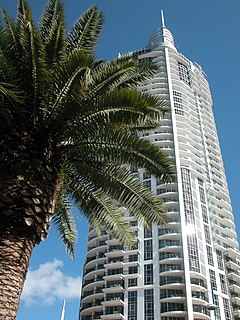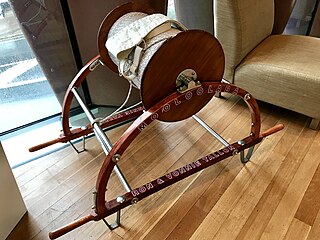
Surf lifesaving is a multifaceted movement that comprises key aspects of voluntary lifeguard services and competitive surf sport. Originating in early 20th century Australia, the movement has expanded globally to other countries including New Zealand, Ireland, South Africa, the United Kingdom. Surf lifesavers in Australia are colloquially known as "Clubbies".

Coogee is a beachside suburb of local government area City of Randwick 8 kilometres south-east of the Sydney central business district, in the state of New South Wales, Australia. It is also a part of the Eastern Suburbs region.

Inflatable Rescue Boat (IRB) racing, is a surf sport in which surf lifesaving club teams race Inflatable Rescue Boats. IRB racing competitions are held in various countries, including Australia, New Zealand, South Africa, the United Kingdom, the United States, Japan, Germany, and France.

Australian rules football matches between teams representing Australian colonies, states and territories have been held since 1879. For most of the 20th century, the absence of a national club competition and international matches meant that football games between state representative teams were regarded with great importance. Football historian John Devaney has argued that: "some of the state of origin contests which took place during the 1980s constituted arguably the finest expositions of the game ever seen".

Nippers are young surf lifesavers, usually aged between 5 and 14 years old, in clubs across Australia, New Zealand and South Africa. Unlike senior surf lifesavers, the majority of them do not patrol the beaches. The focus for Nippers tends to be on fun, and surf awareness.

Surf Life Saving New Zealand (SLSNZ) is the national association representing 74 Surf Life Saving Clubs in New Zealand. The organisation's motto is 'In it for Life'. This refers to both the long relationship many members have with the organisation, as well as to the organisation's purpose of preventing drowning and injury, thereby saving lives.
Lacrosse in Australia is a minor sport, with a long and proud history dating back to 1876, with a small but dedicated community of participants and volunteers. The established centres for lacrosse are in the greater metropolitan areas of Melbourne, Adelaide, and Perth. In these cities there are organised weekend field lacrosse competitions for men and women at senior and junior levels, played over the winter months. In the off-season, there are informal box lacrosse and sofcrosse competitions, though the majority of players in Australia are mostly of the field lacrosse type. Some lacrosse is also played in Sydney, Newcastle, South East Queensland, Canberra and Hobart, it is very much at the developmental level.
The sport of Ironman was developed in 1964 in Australia by Valentine Trainor to combine the four main disciplines of surf lifesaving into a single race; swimming, board paddling, ski paddling and running. The sport should not be confused with Ironman triathlon. It is typically run as a single event as a part of a surf life saving carnival, although it can be run as a sport in its own right. Internationally it is sometimes called Oceanman

Mounted Games is a branch of equestrian sport in which fast games are played on ponies up to a height of 15 hands.
Sport is an important part of the culture of Western Australia.

Sport on the Gold Coast has a rich history. As a popular tourist destination leisure sports like Golf, but most particularly sports associated with its famous beaches, have always been popular. A number of surf clubs line Gold Coasts beaches, who host a variety of swimming and athletic events collected into surf carnivals along with competitions evolved from methods of surf life saving.

The surf life saving reel was a beach life saving apparatus from Australia.
The early life of Mark and Steve Waugh, a set of twins who played Test and ODI cricket for Australia from the 1980s to the 2000s, was characterised by their steady rise through the sporting rankings in a variety of sports.
The RMIT Redbacks are the sport collective of the Australian research University the Royal Melbourne Institute of Technology (RMIT), based at all campuses in Victoria and Ho Chi Minh City, Vietnam. The program is managed by the RMIT Sport team, part of RMIT Student Life.
Mark Trevor "Horse" Bourneville is a New Zealand former professional rugby league footballer. He represented both New Zealand and France in international rugby league and is the only dual-international the two countries share.

Women's soccer, also known as women's football, is a popular sport in Australia. The sport has a high level of participation in the country both recreational and professional. Football Federation Australia (FFA) is the national governing body of the sport in Australia, organising the W-League, the Australian women's national team, and the nine state governing bodies of the game, among other duties. Women's participation of modern soccer has been recorded since the early 1920s. It has since become one of Australia's most popular women's team sports.

John Bloomfield is an Australian sport and sport science academic and author. Bloomfield played a crucial role in the development of the Australian high performance sport system between 1973 and 1989, particularly in relation to the Australian Institute of Sport and the Australian Sports Commission. While active in the above, he lectured and conducted research at the University of Western Australia and, from time to time, in North America and Eastern and Western Europe.

The Umina Beach Bunnies is a rugby league club based on the Central Coast, New South Wales region of Australia.
The history of sport in Australia dates back to the pre-colonial period of the country.

The Bondi Beach Cultural Landscape is a heritage-listed former Turkish baths, pavilion with dressing cubicles, dining rooms, sunbaking, shops and ballroom and now art gallery, pavilion, theatre and open air cinema located at Queen Elizabeth Drive, Bondi Beach, Waverley Municipality, Sydney, New South Wales, Australia. The pavilion was designed by Robertson and Marks, with Leith C. McCredie the architect. The Bondi Surf Life Savers' Club, erected c. 1934, was designed by Ross & Rowe. The Bondi Pavilion was designed by John Howie & Sons. The cultural landscape includes the beach itself, Bondi Surf Pavilion, Bondi Park and Bondi Surf Life Saving Club and the North Bondi Surf Club. The landscape was added to the New South Wales State Heritage Register on 23 May 2008.














